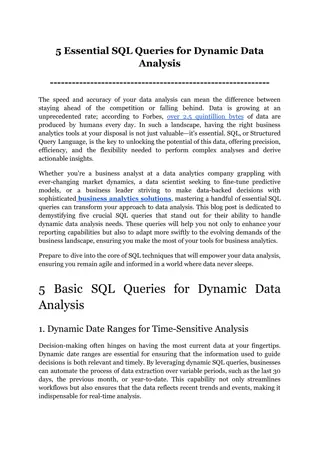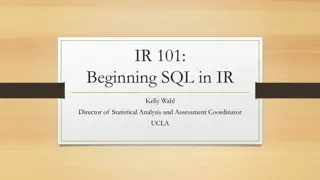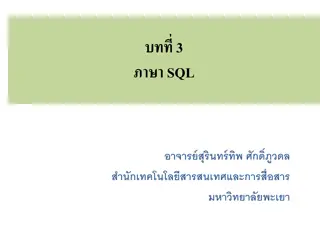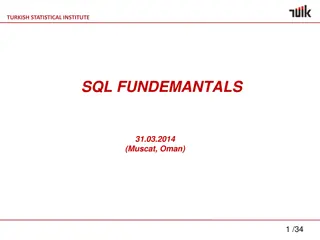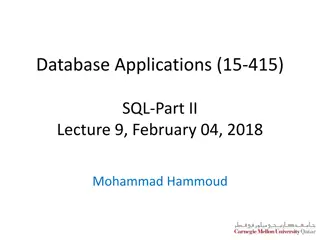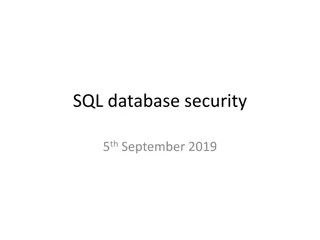
Advanced SQL Queries: Combining Tables for Information Retrieval
Learn how to utilize inner joins and WHERE clause to combine multiple tables in SQL queries for extracting specific data effectively.
Uploaded on | 0 Views
Download Presentation

Please find below an Image/Link to download the presentation.
The content on the website is provided AS IS for your information and personal use only. It may not be sold, licensed, or shared on other websites without obtaining consent from the author. If you encounter any issues during the download, it is possible that the publisher has removed the file from their server.
You are allowed to download the files provided on this website for personal or commercial use, subject to the condition that they are used lawfully. All files are the property of their respective owners.
The content on the website is provided AS IS for your information and personal use only. It may not be sold, licensed, or shared on other websites without obtaining consent from the author.
E N D
Presentation Transcript
MIS2502: MIS2502: Data Analytics Data Analytics Getting Information Out of a Database Part 2: Advanced Queries Part 2: Advanced Queries SQL SQL Getting Information Out of a Database Zhe (Joe) Deng deng@temple.edu http://community.mis.temple.edu/zdeng 1
Querying multiple tables Querying multiple tables Right now, you can answer with data from a single table What if you need to combine two (or more) tables? For example, what if we want to find out the orders a customer placed?
The (Inner) Join The (Inner) Join We ve seen this before Order Table Customer Table `Order` Number OrderDate Customer ID Customer ID FirstName LastName City State Zip 101 2011-3-2 1001 1001 Greg House Princeton NJ 09120 102 2011-3-3 1002 1002 Lisa Cuddy Plainsboro NJ 09123 103 2011-3-4 1001 1001 Greg House Princeton NJ 09120 104 2011-3-6 1004 1004 Eric Foreman Warminster PA 19111 We matched the Order and Customer tables based on the common field (CustomerID) We can construct a SQL query to do this
Joining tables using WHERE Joining tables using WHERE SELECT * FROM orderdb.Customer, orderdb.`Order` WHERE Customer.CustomerID=`Order`.CustomerID; Returns this: Customer. CustomerID Order Number Order. CustomerID FirstName LastName City State Zip OrderDate 1001 Greg House Princeton NJ 09120 101 2011-3-2 1001 1002 Lisa Cuddy Plainsboro NJ 09123 102 2011-3-3 1002 1001 Greg House Princeton NJ 09120 103 2011-3-4 1001 1004 Eric Foreman Warminster PA 19111 104 2011-3-6 1004 Note that all the fields are there, but depending on the database system, the field order may be different.
A closer look at the JOIN syntax A closer look at the JOIN syntax SELECT * FROM orderdb.Customer, orderdb.`Order` WHERE Customer.CustomerID=`Order`.CustomerID; SELECT * Return all the columns from both tables FROM orderdb.Customer, orderdb.`Order` The two tables to be joined WHERE Customer.CustomerID = `Order`.CustomerID Only choose records where the CustomerID exists in both tables Another way to say it: Choose customers that have placed an order The . notation is table_name.column_name We need this when two tables have the same column name.
What If We Dont Have the WHERE condition? What If We Don t Have the WHERE condition? It will fetch every possible combination (pair) of records from the two tables SELECT * FROM orderdb.Customer, orderdb.`Order` WHERE Customer.CustomerID=`Order`.CustomerID; Returns this: Customer. CustomerID Order Number Order. CustomerID FirstName LastName City State Zip OrderDate 1001 Greg House Princeton NJ 09120 101 2011-3-2 1001 1002 Lisa Cuddy Plainsboro NJ 09123 101 2011-3-2 1001 1001 Greg House Princeton NJ 09120 101 2011-3-2 1001 1004 Eric Foreman Warminster PA 19111 101 2011-3-2 1001 1001 Greg House Princeton NJ 09120 102 2011-3-3 1002 1002 Lisa Cuddy Plainsboro NJ 09123 102 2011-3-3 1002 1001 Greg House Princeton NJ 09120 102 2011-3-3 1002 1004 Eric Foreman Warminster PA 19111 102 2011-3-3 1002 1001 Greg House Princeton NJ 09120 103 2011-3-4 1001 1002 Lisa Cuddy Plainsboro NJ 09123 103 2011-3-4 1001 1001 Greg House Princeton NJ 09120 103 2011-3-4 1001 1004 Eric Foreman Warminster PA 19111 103 2011-3-4 1001 1001 Greg House Princeton NJ 09120 104 2011-3-6 1004 1002 Lisa Cuddy Plainsboro NJ 09123 104 2011-3-6 1004
A more complex join A more complex join Question: What products did each customer order? We want to wind up with this view of the database OrderNumber FirstName LastName ProductName Quantity Price 101 Greg House Cheerios 2 3.99 101 Greg House Bananas 3 1.29 101 Greg House Eggo Waffles 1 2.99 102 Lisa Cuddy Cheerios 5 3.99 102 Lisa Cuddy Bananas 2 1.29 103 Greg House Eggo Waffles 3 2.99 104 Eric Foreman Eggo Waffles 8 2.99
How to do it? How to do it? We need information from Customer and Product (and OrderProduct) To associate Customer table with Product table, we need to follow the path from Customer to Product
Heres the query Here s the query SELECT `Order`.OrderNumber, Customer.FirstName, Customer.LastName, Product.ProductName, OrderProduct.Quantity, Product.Price FROM orderdb.Customer, orderdb.`Order`, orderdb.Product, orderdb.OrderProduct WHERE Customer.CustomerID=`Order`.CustomerID AND `Order`.OrderNumber=OrderProduct.OrderNumber AND Product.ProductID=OrderProduct.ProductID; It looks more complicated than it actually is! Note that we have three conditions in the WHERE clause, and we have three relationships in our schema.
Now there are endless variations Now there are endless variations Question: What is the total cost (prices) of all products bought by the customer Greg House ? SELECT SUM(Product.Price*OrderProduct.Quantity) FROM orderdb.Customer, orderdb.`Order`, orderdb.Product, orderdb.OrderProduct WHERE Customer.CustomerID=`Order`.CustomerID AND `Order`.OrderNumber=OrderProduct.OrderNumber AND Product.ProductID=OrderProduct.ProductID AND Customer.CustomerID=1001; You could have also said Customer.LastName= House , but it s better to use the unique identifier. Answer:23.81
Whats with the SUM() function? What s with the SUM() function? Notice that we ve introduced something new SELECT SUM(Product.Price*OrderProduct.Quantity) This multiplies price by quantity for each returned record, and then adds them together. You can perform arithmetic operations as long as the fields are numeric Question: What do you think would get returned if you left off the SUM() and just had SELECT Product.Price * Product.Quantity?
Recall the LIMIT Clause Recall the LIMIT Clause We could try to use LIMIT to find the least expensive product: SELECT * FROM orderdb.Product ORDER BY Price ASC LIMIT 1; But what if there is more than one product with the lowest value for price AND we don t know how many there are?
Where MIN() alone fails us Where MIN() alone fails us Price SELECT MIN(price) FROM orderdb.Product; 1.29 BUT SELECT MIN(price),ProductName FROM orderdb.Product; Price ProductName 1.29 Cheerios Wait . Cheerios price should be 3.99. So what s going on??
Whats wrong What s wrong SELECT MIN(price),ProductName FROM orderdb.Product; Price ProductName It returns the MIN(price): $1.29 1.29 Cheerios MIN() will always return only one row And it will do this for any function (AVG, SUM, etc.) So for ProductName, it chooses the first row in the Product column, i.e., Cheerios
So we need a SQL So we need a SQL subselect subselect statement statement It s where you have a SELECT statement nested inside another SELECT statement! SELECT Price,ProductName FROM orderdb.Product WHERE Price=( SELECT MIN(Price) FROM orderdb.Product ); Now you get all records back with that (lowest) price and avoid the quirk of the MIN() function. This is a temporary table from the database with one column and one row.
How would SQL execute this query? How would SQL execute this query? SELECT Price,ProductName FROM orderdb.Product WHERE Price=( SELECT MIN(Price) FROM orderdb.Product ); SELECT MIN(Price) FROM orderdb.Product Step 1: Execute what is in the parentheses to find the lowest price MIN(Price) 1.29 Step 2: Plug the lowest price into the main query, and execute the main query SELECT Price,ProductName FROM orderdb.Product WHERE Price=1.29; Price ProductName 1.29 Bananas
Subselects Subselects come in handy in other situations too come in handy in other situations too We want to get a COUNT of how many DISTINCT states there are in the table. SELECT COUNT(*) FROM (SELECT DISTINCT State FROM orderdb.Customer) AS tmp1; To see how this works: Start with what is in the parentheses SELECT DISTINCT State FROM orderdb.Customer State NJ PA then COUNT those values 2
Why do we need AS? Why do we need AS? SELECT COUNT(*) FROM (SELECT DISTINCT State FROM orderdb.Customer) AS tmp1; You re basically SELECTing from the temporary table generated by the nested query. But since you re SELECTing FROM that temporary table you have to give it a name (i.e., tmp1)
Subselects Subselects with Joins with Joins Question: What is the least expensive product bought by customers from New Jersey? To do this, we will need all the tables.
Subselects Subselects with Joins with Joins First, we need to figure out the lowest price of products by customers from New Jersey? SELECT MIN(Product.Price) FROM orderdb.Customer, orderdb.`Order`, orderdb.Product, orderdb.OrderProduct WHERE Customer.CustomerID=`Order`.CustomerID AND `Order`.OrderNumber=OrderProduct.OrderNumber AND Product.ProductID=OrderProduct.ProductID AND Customer.State='NJ'; Price 1.29 But this is not enough We also need to find the product name.
Subselects Subselects with Joins So we nest the previous query in a big query: with Joins SELECT Product.ProductName, Product.Price FROM orderdb.Customer, orderdb.`Order`, orderdb.Product, orderdb.`Order-Product` WHERE Customer.CustomerID=`Order`.CustomerID AND `Order`.OrderNumber=OrderProduct.OrderNumber AND Product.ProductID=OrderProduct.ProductID AND Customer.State='NJ' AND Product.Price=( SELECT MIN(Product.Price) FROM orderdb.Customer, orderdb.`Order`, orderdb.Product, orderdb.OrderProduct WHERE Customer.CustomerID=`Order`.CustomerID AND `Order`.OrderNumber=OrderProduct.OrderNumber AND Product.ProductID=`Order-Product`.ProductID AND Customer.State='NJ ); ProductName Price Bananas 1.29
Pattern Match Search Condition Pattern Match Search Condition When searching for text, sometimes we want inexact match (e.g. like find all lastnames starting from A ) We can use LIKE/NOT LIKE and % to test whether a string matches a specified pattern WHERE col_name LIKE %berry : will find all the text strings like berry , cranberry , blackberry and so on. WHERE col_name LIKE %d% : will find all the text string that contain d letter. WHERE col_name NOT LIKE %d% : will find all the text string that do not contain d letter.
Pattern Match Search Condition: Pattern Match Search Condition: Example Example List all the customers who live in the city that starts with P letter CustomerID FirstName LastName City State Zip 1001 Greg House Princeton NJ 09120 1002 Lisa Cuddy Plainsboro NJ 09123 1003 James Wilson Pittsgrove NJ 09121 1004 Eric Foreman Warminster PA 19111 SELECT * FROM orderdb.Customer WHERE City LIKE p% ; What s going to be the result?
Summary Summary Given a schema of a database, we now should be able to create a SQL statement (query) to answer a question Understand how to use SELECT FROM DISTINCT WHERE (and how to specify conditions) AND/OR ORDER BY (ASC/DESC) Functions: COUNT, AVG, MIN, MAX, SUM GROUP BY LIMIT Joins Subselects
Time for our 5 Time for our 5th th ICA! ICA!


